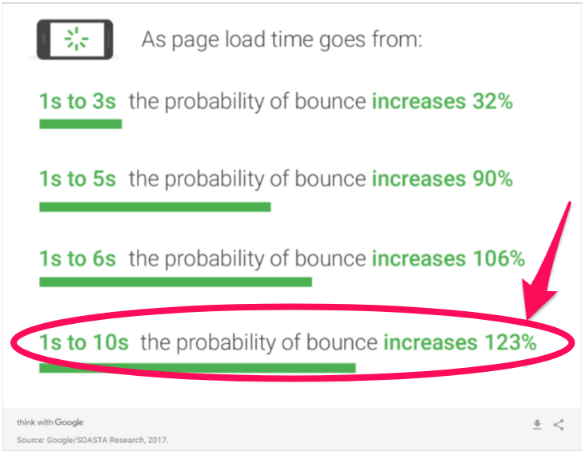What is the bounce rate and how to calculate it

This rate indicates the number of people who land on a webpage but do not interact with it. In other words, they do not click on any CTA buttons, register their email if there is a lead magnet, visit other tabs within the page, etc.
In short, they do not make any clicks.
This metric is often confused with the exit rate; however, both provide different indicators of user behavior on a website.
Bounce Rate vs Exit Rate
Let’s imagine comparing the bounce rate and exit rate of a thank-you page. A high bounce rate on this page would be concerning because it means that people are only viewing that page and then clicking away. Worse, they didn’t complete a form to get there, meaning you’re losing conversions.
A high exit rate, on the other hand, wouldn’t be a cause for concern. It would mean that this page was the last in a chain of visits: people leaving that page probably came from a previous landing page, downloaded the offer on the thank-you page, and left to use the content they just downloaded.
Remember, this scenario is hypothetical and these conclusions may differ based on other metrics of the page, but it serves as a simple illustration of the difference between bounce and exit rates.
Formula for Bounce Rate
Since the bounce rate is the percentage of visitors who only view one page on your site, it is calculated by dividing the total number of single-page visits by the total number of visitors.
For example, if 100 people visit your site and 10 of them only visit one page, then your bounce rate would be 10%. This number will likely change over time, so using an analytics provider to track all changes is beneficial for understanding what is affecting your bounce rate.
¿Why is Bounce Rate Important?
If this rate is high, the webpage might not be achieving its objectives, and user expectations may not be satisfied.
This metric allows, among other things, to determine if the content is engaging or if, on the contrary, website optimization is needed to promote more interaction with users upon entry, as well as to understand the positioning and overall status of the site.
A high bounce rate is negative for any type of business website, as it indicates there was nothing else relevant for the visitor.
This is particularly true for the homepage, which is generally designed to distribute visitor traffic to the rest of the site’s content or other embedded pages.
According to MonsterInsights, some markets or industries tend to have higher bounce rates than others. For example:
- Retail Sites: 20% to 40%
- Simple Landing Pages: 70% to 90%
- Portals: 10% to 30%
- Service Websites: 10% to 30%
- Content Sites: 40% to 60%
- Lead Generation Pages: 30% to 50%
However, some pages with a high bounce rate are not necessarily bad.
For instance, landing pages without links to any other page, aiming only to capture emails or other relevant information for lead generation, may naturally have a high bounce rate.
Or, pages that provide a specific definition someone searched for on Google will undoubtedly have a high bounce rate, which isn’t necessarily negative here, as it delivered the information the visitor was seeking and then left.
It’s important to know this because the bounce rate does not measure the duration of a visitor’s stay.
That is, someone might spend 15 minutes reading an article and then leave without interacting with another link or CTA button on the website.
What is considered a good bounce rate
If you’ve recently checked your website’s bounce rate, you might feel discouraged by the number. But aiming for a 0% bounce rate will probably leave you feeling even more disheartened. The average bounce rate lies somewhere between 26% and 70%, with the optimal range being between 26% and 40%. Landing anywhere below 20% is generally unlikely, so if that’s what your data shows, you might want to check a few things. Duplicate code, improperly implemented tracking, and third-party plugins can result in inaccurately reported bounce rates.
The average bounce rate can also vary depending on the user’s device. For example, mobile devices have the highest bounce rate across all industries at 51%. Meanwhile, the average bounce rate on desktop is 43%, and for tablets, it’s 45%. Therefore, consider where your traffic is coming from as you assess your site’s bounce rate.
What is Considered a High Bounce Rate
A bounce rate above 70% is above average, but it’s not considered high until it reaches 56%. If it’s above 90%, that’s a major cause for alarm, but usually, it’s easy to reduce because there’s something specific that’s scaring everyone away. Issues like poor design, errors in your tracking code, excessive bots, or browser incompatibility might be to blame. Also, keep in mind that high traffic from social media or paid ads, as well as a large number of mobile visitors, can increase your bounce rate too.
¿Is Bounce Rate a Ranking Factor?
Bounce rate is not a ranking factor confirmed by Google. It’s just a metric, and Google has repeatedly stated that it doesn’t directly influence rankings (although some studies have shown a correlation between bounce rate and ranking).
But you should try to improve your bounce rate. Why?
A high bounce rate is often a symptom of weaknesses in other SEO factors, like slow loading speed, poor page design, mismatch between content and keywords, and poor mobile optimization.
When someone ‘fixes’ your bounce rate, they are usually addressing one of these issues.
Moreover, a lower bounce rate generally indicates that your content is engaging or useful, and that’s something Google definitely values.
How to decrease the Bounce Rate
Before implementing techniques to reduce the bounce rate, you should analyze whether it’s good or bad based on the objectives for which the page is designed.
For example, if it’s a content-only page, a high bounce rate might not be bad, as we mentioned in the previous example. But if visitors aren’t completing or engaging as expected according to the website’s design, it may be necessary to find ways to reduce the bounce rate.
1. Improve Content Readability.
When a page is overloaded with large blocks of text, it tends to lose people’s interest more quickly.
Break up the content with subtitles, bullet points, related images, and use short, clear, concise, and high-quality paragraphs.
2. Include a Clear and Direct Call to Action.
Every web page should have a purpose, something you want the visitor to do upon arriving.
This could be:
- Registering their email to receive newsletters or for email marketing strategies.
- Sharing the page on social media.
- Writing a comment.
There are many options depending on your goals, so place an accessible, visible, and clear CTA for users.
3. Avoid Distractions on the Website.
Reducing distractions, usually located in the right sidebar, is another effective strategy to reduce the bounce rate.
Place only necessary content or banners there.
This also applies if your website hosts Google paid advertising. Assign spaces that don’t overly disrupt the website design or select ads that truly match your content.
4. Use relevant Keywords.
In designing a digital marketing strategy, especially for SEO growth, it’s important to use relevant keywords.
Analyze if you’re positioning the right words to attract visitors genuinely interested in your content.
5. Avoid pntrusive popups.
Some pages place popups that predict visitor cursor movements, which can be annoying.
Ensure the popup is necessary and appears at the right moment.
6. Use Internal Links
As you can see in our posts, we use internal links to encourage you to read more of our content. This is a technique called internal backlink generation.
So, link blog entries with direct access to products or other related posts. This will make people more interested in visiting other pages of your site and generate greater interaction.
7. Optimize Loading Speed
Page speed can make or break the user experience. As page loading time increases, so does the likelihood of someone leaving the page (or bounce rate), by a lot.
A Google page speed study that evaluated 11 million pages confirms this correlation.
Here’s a look at how loading times relate to the likelihood of a user leaving the page:

Juan Esteban Yepes
